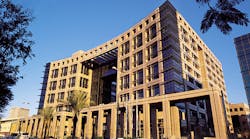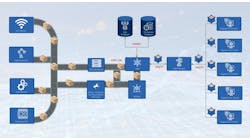Industrial Internet of Things (IIoT) and telecommunications company RAD named Udy Kashkash as its president and CEO. He is a 25-year industry veteran who’s been with RAD for five years.
He replaces Dror Bin, who was appointed as the CEO of the Israeli Innovation Authority. Kashkash joined RAD in 2016 as the head of North American operations. He later took on the position of vice president, customer facing group, before being named CEO. Prior to joining RAD, Kashkash served in various positions for telecom vendors, including vice president of sales for Ceragon Networks and sales and business development manager for Mobile Backhaul Solutions in North America for Nokia Siemens Networks. Kashkash also held several senior R&D positions at Nokia Siemens Networks and Seabridge. He has a degree in computer science.
“RAD’s shareholders and board of directors strongly believe in the company’s management team and Udy’s promotion to CEO proves that,” says Yehuda Zisapel, RAD’s chairman of the board and president of the RAD-Bynet Group.
What are three key things that a machine builder, system integrator or manufacturer should know about your organization?
Udy Kashkash, president and CEO, RAD: RAD is a leading telecommunications access solutions provider. This year, we’re celebrating our 40th anniversary. During this time, we’ve been working extensively with organizations around the world to help them ensure always-on reliability for their mission-critical communications. We’re part the of $1.45 billion RAD Group and have a global presence. RAD is also a pioneer in secure industrial IoT solutions with edge computing, and one of our key areas of focus has been IoT solutions in service of the smart factory to address the communications requirements of Industry 4.0 projects.
What new technologies are driving product development and why?
Udy Kashkash, president and CEO, RAD: There are a few technologies that we believe are vital for innovation in this field, all of which are related to the Industrial Internet of Things. First, there’s edge computing, which allows data produced by sensor-rich assets to be processed closer to where it is created. Because the data doesn´t need to be sent across long routes to data centers or cloud services, this means that we can achieve ultra-low latency communications at the edge to support real-time decisions and actions. For example, if an anomaly is detected, then real-time local actions can be triggered to support predictive maintenance, among others.
Edge computing also means that software-based virtualized functionalities, such as a virtual firewall, are hosted by the IIoT gateway that collects the data from the sensors and communicates with the control room and cloud server. Container technology is best fitted for this purpose, as it’s much more cost-efficient than hosting virtual machines.
Then there’s IoT SCADA and message queuing telemetry transport (MQTT), the architecture that is at the basis of the new generation of connectivity between PLCs and the control room, which is also widely used for cloud-based IoT dashboards and analytics. These have become critical for decision makers.
Additional technologies we’re focusing on are operational network (OT) cybersecurity, protocol conversion to enable legacy PLC and other devices to speak to the MQTT server and LoRaWAN—the low-power wireless wide area network technology that connects low-bandwidth, battery-powered IoT devices.
How does the Industrial Internet of Things figure into business strategy?
Udy Kashkash, president and CEO, RAD: IIoT is one of our key areas of growth. That is why we’ve developed the SecFlow, which is a Swiss army knife, in that it combines, in a single box, functionalities that would typically require separate dedicated appliances. The SecFlow supports much more than the networking functionality. In fact, it is the only solution in the market today that combines a router, firewall and an LTE modem, together with a PLC, LoRaWAN gateway, protocol convertor, video surveillance DVR and other functions hosted as containers. This is a much-appreciated feature among IoT project managers as it simplifies deployment and operations by reducing the number of devices and contributes to increased security. This value proposition is also the reason why it has already won three IoT Evolution awards.
We’re also paying special attention to growing our IIoT ecosystem to fit more use cases, with strategic partners of sensors, IoT platforms, dashboard and analytics, for example, our recently announced partnership with Actility.
How will machine automation and controls alter the way companies staff their operations in the future?
Udy Kashkash, president and CEO, RAD: The combination of real-time, actionable data delivery, cloud-based analytics and IIoT implementation will enable manufacturers to extract even more value from production and machine-automation processes. Ultimately, Industry 4.0 would mean that connected workers and connected machinery share a cyber-physical space where processes are integrated and decisions are made both in real-time and over time as unprecedented amounts of newly available data is turned into insights. This would also translate into a different skillset required from operations staff. While this new skillset might not go as far as code writing, as there are already I4.0 solutions out there that present a simple user interface for easy introduction of process changes, it will require data-analysis capabilities.
How is the development of software solutions impacting requirements for hardware?
Udy Kashkash, president and CEO, RAD: The availability of edge computing enables local computing and processing of data to be completed before the necessary data is sent to the server. This means that, on the one hand, the compute platform and operating system within the IIoT gateway must be powerful enough to run such applications, and, on the other hand, the gateway must be economical to ensure an attractive price/performance ratio—for example, by using the more cost-effective container technology rather than x86 silicon, or minimizing the size of memory resources required by the operating system (OS).
As engineering and IT continue their convergence, which one is and/or will be leading the direction of future automation and technology?
Udy Kashkash, president and CEO, RAD: While IT focuses on digital systems that process and produce information, such as enterprise resource planning (ERP), OT focuses more on digital systems that monitor and manage physical processes, PLCs, sensors, RTU devices, infrastructure and events like SCADA. Traditionally, information technology and operational technology were used to perform separately as most of the control systems have separate protocols and closed network communication systems. With the development of IoT and Industry 4.0, the integration of automation control and industrial communication systems has led to the formation of an integrated system, which is used in industrial IoT ecosystems. Over time, OT needs to adopt the core elements of IT systems and security management.
Looking into the future, how will technology change your organization or other organizations over the next five years?
Udy Kashkash, president and CEO, RAD: As a technology innovator we naturally strive to be the source of change in telecommunications technologies but are, of course, also influenced by this very same change. I see four main drivers for change in our industry, and these drivers are amalgamating in interesting ways.
First, softwarization is the paradigm shift wherein networking functionality is performed by software, rather than by dedicated hardware. RAD was an early driver for edge computation and distributed network function virtualization (NFV), and we believe that our decades of experience enable us to provide better solutions, whether hardware- or software-intensive (Figure 1).
Also read: Where is automation headed?
Second, 5G’s real advantages will be in the realms of Industrial IoT and advanced services. These are RAD’s main markets, and we see 5G as energizing our backyard, as well as encroaching on our conventional turf.
Third, the cloud and its evolution into the edge cloud is now maturing into an infrastructure for hosting virtual network functions.
Finally, the trend is toward smart-X, where X may be a factory or a fleet or many other applications. This trend is almost synonymous with IoT, is driving and is driven by 5G and will change the entire way we function as individuals and as a society.







